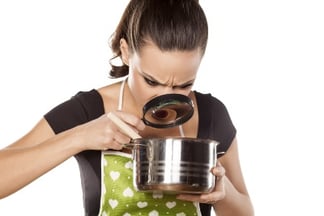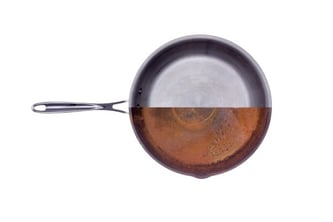 Do you know where the pots and pans in your kitchen came from? Do you know what they are made of? Do you know if they leak chemicals into your food? These are important questions to ask that lab tests for cookware can help you to answer.
Do you know where the pots and pans in your kitchen came from? Do you know what they are made of? Do you know if they leak chemicals into your food? These are important questions to ask that lab tests for cookware can help you to answer.
Imagine coming home from a day at work and all you can think about is cooking up a delicious meal in your new pan. You start to heat up the pan when you hear a strange sound, you frown and inspect the pan when suddenly a hot metal disc shoots off and strikes you in the face.
This is what a few customers of Macy’s had to deal with late last December. People heating up the stainless steel cookware for a meal were burned and bruised by metal discs that popped off of the pans. This led the manufacturer to issue a recall of 121,000 cookware sets.
The last thing any importer wants is a damaging product recall due to safety concerns. Cookware products carry higher risks for safety issues and must be subjected to tests beyond what ordinary QC personnel can typically perform at a factory. Being familiar with these lab tests for cookware can help you ensure you’re buying or importing a quality product that is safe for your customers.
1. Food contact testing for cookware
Food contact testing applies to any product or packaging that’s meant to come in contact with food. Food contact testing determines overall chemical migration and the presence of any residual substances. This testing looks for residual materials remaining on the product following manufacturing.
"Food contact testing determines overall chemical migration and the presence of any residual substances."The Food and Drug Administration (FDA) offers information for various safety guidelines and regulations applied to cookware. You might have to be more (or less) strict when applying this food contact testing to your own product.
2. Material verification for cookware
When thinking about lab tests for cookware, consider all the minor components that go into makin g the item. As we can see from the Macy’s recall, the metal discs from those pans needed to be more secure as the heating of the pan caused an increase in pressure. Another example is screws that are inserted into the cookware. They should be tested for material verification to ensure they fit the chemical requirements and pass the standards of the regional market.
g the item. As we can see from the Macy’s recall, the metal discs from those pans needed to be more secure as the heating of the pan caused an increase in pressure. Another example is screws that are inserted into the cookware. They should be tested for material verification to ensure they fit the chemical requirements and pass the standards of the regional market.
3. Performance testing for cookware
Arguably the most important test, the performance test subjects your product to a variety of smaller tests, some of which include lab testing for:
- Thermal shock - Tests for durability after a sudden and rapid change in temperature
- Heat exposure - Tests if the product can withstand the high temperatures associated with cooking
- Boil-dry - Tests for product integrity after heating the product with nothing inside
- Freezer safety - Tests for durability of product in very low temperatures
- Dishwasher safety - Tests for durability after multiple runs through the dish washer
- Acid resistance - Tests for durability of the product through different acids and oils that it may come into contact with
- Accelerated corrosion - Similar to the salt spray test below, this tests for corrosion and oxidation of the metals in the pan
These small tests will give you a comprehensive understanding of your product and how it compares to what’s offered by your competitors. The thermal shock test and heat exposure test would have been good indicators for Macy’s. The issue with the metal discs could have been found and addressed prior to shipment, and most importantly, prior to sale and use by end consumers.
4. Salt spray corrosion testing for cookware
 A common corrosion test method, this test is used to check your cookware’s resistance to rust. With this test, you can quantitatively determine how well an item of cookware resists corrosion. This test verifies that a pot or skillet is appropriately resistant to corrosion and oxidation by spraying a 1 percent salt solution on the pan and letting it sit for 24 hours. If rust is found after 24 hours, then that is an issue that needs to be addressed.
A common corrosion test method, this test is used to check your cookware’s resistance to rust. With this test, you can quantitatively determine how well an item of cookware resists corrosion. This test verifies that a pot or skillet is appropriately resistant to corrosion and oxidation by spraying a 1 percent salt solution on the pan and letting it sit for 24 hours. If rust is found after 24 hours, then that is an issue that needs to be addressed.
5. Exterior chemical testing for cookware
One of the more technical lab tests for cookware, exterior chemical testing examines the release of different chemicals from a specific area of the cookware. Different material covering different areas of the item can be problematic and potentially hazardous for your customers if not checked thoroughly.
"Exterior chemical testing examines the release of different chemicals from a specific area of the cookware."For example, if you look at the rim of a skillet or pot, you'll find it looks different than the rest of the item. The rim is a problem area in terms of chemical leak because it is the edge. While the rest of the item is usually sealed with a coating, the edge is bare.
Conclusion
Being an importer of cookware products holds you liable for more than just the visible quality aspects of your products. Cookware is a relatively sensitive product type since it deals with high heat and food preparation. And hazards like those met by customers at Macy’s could lead you to suffer huge financial and legal setbacks.
Be sure to consider these five lab tests for cookware. They will help you identify potential issues with your product before it leaves the factory.







